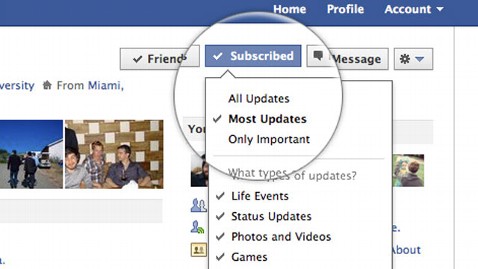Facebook Smart Lists, Subscribe Button Offer Control Over Content

Facebook is launching a new "subscribe" button.
Facebook is rolling out two new features today which, borrowing heavily from Google Plus and Twitter, will allow users to customize what content they see in their news feed.
The Smart Lists will automatically group a Facebook user’s friends by where they live, where they work, or where they went to school and allow users to pick which type of content each group can see. For example, a user can post photos of their Friday night party to their school friends, while only allowing coworkers to see updates about their professional life.
The new tool borrows a page from the book of Google Plus, which, when it launched over the summer, organized friends into “circles” based on the things they have in common with the user. Users can then pick which circles see which content on their profiles.
In traditional Facebook fashion, the roll out today will be automatically ingrained into profiles beginning today, and users will have to change their settings to opt-out.
In another move aimed at helping users sort through content, Facebook will begin allowing users to subscribe to the streams of other people regardless of whether they are friends with the person. The function is much like Twitter’s “Follow” button, which allows users to subscribe to the Twitter streams of a complete stranger.
Naomi Gleit, a product manager who helped develop the Subscribe button, said the button will enable users to subscribe to interesting people like bloggers or journalists.
“This will allow people to broaden conversations beyond just their friends,” Gleit said.
The subscribe tool will also allow users to pick which updates they get from friends–users can choose “all,” “most,” “important news only,” or “none,” effectively editing out posts that the user doesn’t want to see. Gleit used the example of a user who might not want to see dozens of status updates about Facebook games; the user can now opt not to see those updates in their stream.
“Say you are friends with someone you went to high school with but don’t don’t really talk to anymore,” Gleit said. “You might want to subscribe to only their important updates, like when they move to a new city, have a baby, or get a new job.”
Gleit stressed that the new functions are totally optional for users, who will have to opt-in to have a “subscribe” button appear on their profile.
“A lot of people want more customization over what updates they see in their feed,” Gleit said. “As Facebook has gotten bigger and people have more friends, they just want to see updates that are important to them.”